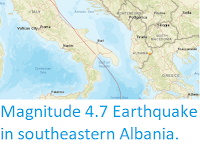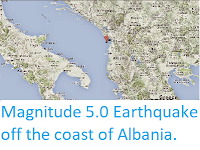The United States Geological Survey
recorded a Magnitude 6.4 Earthquake at a depth of about 20.0 km, roughly
12 km to the southwest of the town of Mamurras in western Albania, slightly before 3.55 am local
time (slightly before 2.55 am GMT) on Tuesday 26 November 2019. The quake has caused widespread damage in Albania, with many collapsed buildings and at least twenty fatalities, and over six hundred people are reported to have been injured. The event was felt across the Balkan Peninsula and Italy. The worst casualties occurred in the town of Durrës, where at least six buildings collapsed, including an apartment block.
Damaged buildings in the town of Durrës in western Albania, following a Magnitude 6.4 Earthquake on Tuesday 26 November 2019. Hektor Pustina/AP.
The coastal region of Albania, and the other states of the western
Balkan Peninsula, forms the eastern margin of the Adriatic Plate, a
piece of the African Plate that has broken away and is now wedged into
the southern part of the Eurasian Plate. This is being squeezed by the
impact of Africa into Europe from the south, which is pushing western
Italy, which sits on the Eurasian Plate, to the east, and Greece and
Turkey, which sit on the Aegean and Anatolian Plates, to the west. This
squeezing leads to uplift around the margins of the Adriatic Plate, in
the Apennines Mountain Range of central Italy and the mountain ranges of the
west Balkan Peninsula.
Outline map showing the approximate positions of the Eurasian (EU), Adriatic (AD) and African (AF) Plates. Di Bucci & Mazzuli (2003).
Witness
accounts of Earthquakes can help geologists to understand these events,
and the structures that cause them. The international non-profit
organisation Earthquake Report is interested in hearing from people who may have felt this event; if you felt this quake then you can report it to Earthquake Report here.
See also...
Follow Sciency Thoughts on Facebook.








